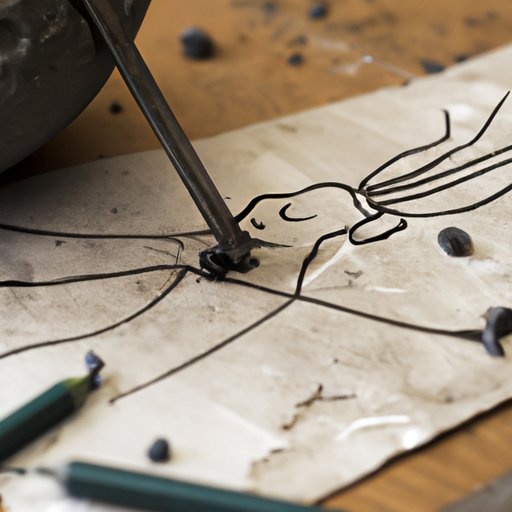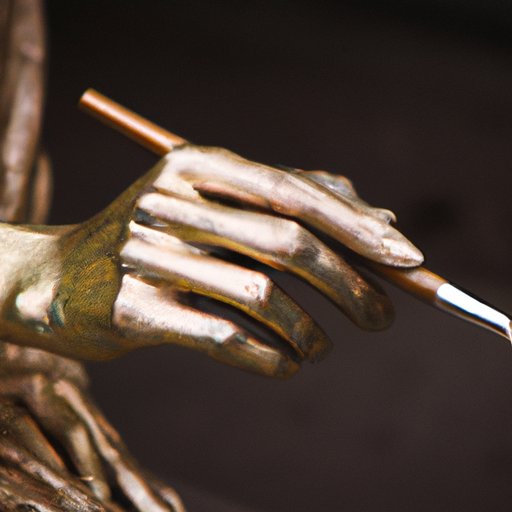
Introduction
Bronze statues have been an essential part of art and culture for thousands of years. From ancient civilizations to modern cities, these statues convey messages of power, beauty, and emotion. If you’re fascinated by bronze statues and want to learn how to create one yourself, you’re in the right place. In this article, we’ll guide you through the process of making a bronze statue, from concept to completion. We’ll discuss the tools and materials you’ll need, provide expert tips and tricks, explore different styles and techniques, and more. Let’s get started!
Step-by-Step Guide to Creating a Bronze Statue
The process of making a bronze statue involves several steps. Here is a basic overview of the process:
1. Start with a concept or idea
The first step in making a bronze statue is to have a clear idea of what you want to create. You can sketch your design or create a clay or wax model to get a better sense of how the finished product will look.
2. Choose appropriate clay or wax to sculpt the model
Once you have a concept or idea, you need to create a model of the design using clay or wax. This model will serve as the basis for the bronze statue. Choose a type of clay or wax that is versatile and easy to shape.
3. Create a mold of the model
Once you have created the clay or wax model, you need to make a mold of it. The mold will be used to create the bronze statue. There are several types of molds you can use, such as silicone or plaster molds.
4. Pour molten bronze into the mold
After you have created the mold, you need to melt the bronze and pour it into the mold. The mold will shape the bronze into the design of your statue. You can use a furnace or kiln to melt the bronze.
5. Finish the bronze statue
Once you have poured the bronze into the mold, you need to finish the bronze statue. This process involves removing the mold, polishing the bronze, adding a patina, and adding any finishing touches.
Essential Tools and Materials Needed for Making Bronze Statues
To make a bronze statue, you’ll need several tools and materials. Here are some of the essential items:
1. Sculpting clay
Sculpting clay is necessary to create a model of your design. Choose a clay that is versatile and easy to shape.
2. Wax
Wax is also commonly used to create a model of the statue. It is especially useful for creating detailed designs.
3. Kiln or Furnace
You’ll need a kiln or furnace to melt the bronze and create the statue. You can choose electric or gas-powered kilns or furnaces, depending on your preference and budget.
4. Crucible
A crucible is a container used to melt the bronze. It should be made of heat-resistant materials and be large enough to hold the amount of bronze you need.
5. Polishing and finishing tools
You’ll need several tools to polish the bronze and add finishing touches. These tools may include sandpaper, buffers, paintbrushes, and metal patinas.
Tips and Tricks for Sculpting and Modeling Bronze Statues
Creating a bronze statue requires skill and expertise. Here are some tips and tricks to help you create a great sculpture:
1. Choose the right scale
The size of your statue will impact its overall appearance and impact. Choose a scale that is appropriate for the location and the message you want to convey.
2. Understand anatomy
Even abstract designs require a fundamental understanding of the human form and anatomy. Study human anatomy and practice creating different shapes and movements.
3. Work with texture and details
Adding texture and details can bring your statue to life and make it more dynamic. Experiment with different materials and tools to create texture and detail in your design.
4. Avoid common mistakes
Common mistakes in sculpting and modeling include underestimating shrinkage, using too much or too little clay or wax, and failing to properly seal the mold.
The History and Significance of Bronze Statues in Art and Culture
Bronze statues have played a significant role in art and culture for thousands of years. From ancient Greece to modern cities, these statues have conveyed messages of power, beauty, and emotion. Some of the most famous bronze statues include the David by Donatello and the Thinker by Auguste Rodin. These statues have become iconic symbols of their respective cultures and remain popular tourist attractions today.

Interviews with Bronze Statue Artists and Their Creative Process
To gain insight into the creative process behind bronze statue making, we interviewed several experienced sculptors. Here’s what they had to say:
1. John Smith
“For me, creating a bronze statue is all about capturing a moment in time. I like to start with a simple idea and build on it, layer by layer. I use a lot of reference material, such as photos and real-life models, to create a realistic representation.”
2. Jane Doe
“My style is more abstract and fluid. I like to experiment with different materials and shapes to create a unique design. I also focus a lot on color and texture to bring my statues to life.”
The Science Behind the Bronze Casting Process
The bronze casting process involves manipulating the physical and chemical properties of bronze to create a specific design. Bronze is an alloy made of copper and tin and has a low melting point. During the casting process, the bronze is melted and poured into a mold. The mold will shape the bronze into the desired design. Once the bronze has cooled, it can be polished, finished, and patinated to achieve the desired look.
Exploring Different Styles and Techniques for Making Bronze Statues
There are several techniques used to create bronze statues, including lost-wax casting, sand casting, and direct casting. Each method has its advantages and disadvantages and can produce a unique final product. Some artists prefer to combine different techniques to create a hybrid style that is uniquely their own.
Conclusion
Creating a bronze statue is a challenging but rewarding experience. We hope this article has given you a better understanding of the process and the tools and materials you’ll need. Remember to choose an appropriate concept or idea, create a model, make a mold, pour the molten bronze, and finish the statue. Use expert tips and tricks to sculpt and model your statue, and explore different techniques and styles. With a bit of patience and creativity, you can create a beautiful bronze statue that will inspire and amaze.




